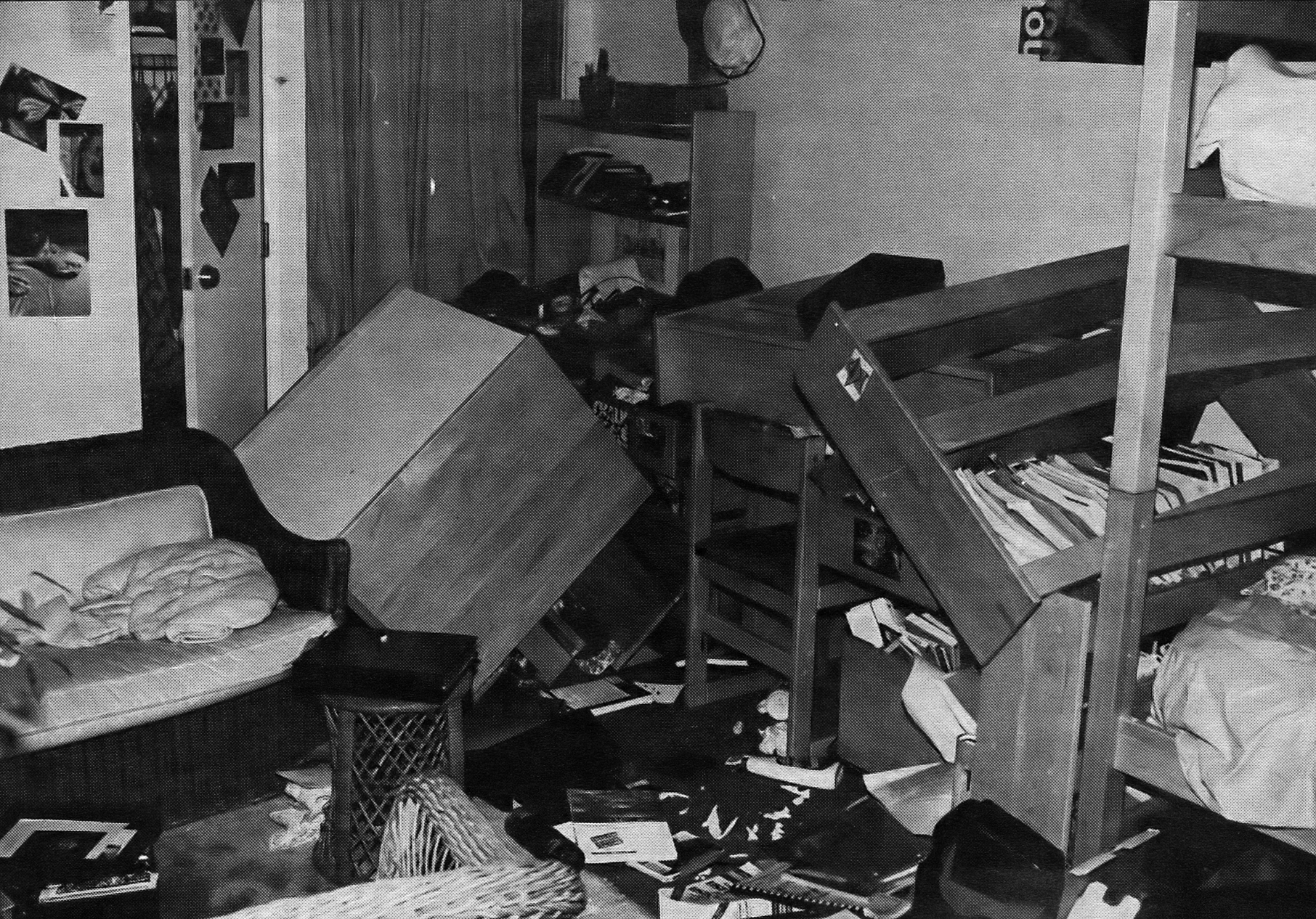
UCLA students disregard yellow tape barriers as they quickly make their way up Janss Steps after the 1994 Northridge earthquake crisis. The Southern California earthquake killed 57 people and caused $20 billion in property damage.
The rumbling sounded like somebody was jumping up and down on his floor at 4:31 a.m.
But when resident assistant Todd Sargent realized it was an earthquake, he was still too sleepy to rise from bed. It was Jan. 17, 1994, and Sargent was experiencing what every resident of Southern California would not forget: the Northridge earthquake that took with it 57 lives and $20 billion in property damage.
The alarm set in 20 seconds later, when the quake ended and left students trapped on the second floor of Sproul Hall. Students climbed onto window ledges. They gingerly made their way toward other windows that led to rooms with unblocked doors.
Meanwhile, in Hedrick Hall, the quake jolted Delaphine Hudson out of bed and she could hear panicked screams.
But the resident director felt calm and ready to follow protocol. She met with resident assistants and began accounting for students in her building.
“I respect resident life at UCLA because everyone had to be trained (for disasters),” she said.
Following the 9.0 earthquake in Japan 17 years later, administrators on the Hill still make preparedness a major priority.
The Hill’s understanding of earthquakes has evolved since the 6.7 magnitude earthquake over a decade ago, and administrators have made many changes to get ready for the next big one. Unlike campus buildings like Powell Library and Royce Hall, the Hill sustained minimal damage, mainly because the seismic renovations for the four residence halls began during the late 1980s.
But getting to resources was harder than it should have been on the Hill, especially because many resources were centralized rather than spread out.
Junji Toshima, access control manager for Housing and Hospitality Services, has been working to provide easier access to and faster deployment of resources for dorm residents.
Toshima said it took longer than necessary to reach water in 1994. Water tanks that are preheated through solar energy on the roofs of buildings on the Hill had moved off their foundations during the shaking.
Now they are bolted down, Toshima said. Together they contain 60,000 gallons of drinkable water, which can be accessed in the event of emergencies.
Faucets below the tanks allow for hoses to be flung over the roofs to fill bladder bags in pickup trucks, which would then deliver drinking water to the Hill.
To ensure food sources, Toshima said the Hill is entering into special supply contracts with off-campus vendors who could bring food in an emergency, and Dining Services has developed an emergency dining menu.
A trailer with bulk emergency supplies rests in the Easton Stadium near Sunset Canyon Recreation Center, but now every resident assistant also has a backpack kit filled with medical and search supplies for their floors.
At each front desk, evacuation chairs are available to help the injured evacuate and glide downstairs with ease.
Analyzing emergency generator resources are more of a priority now as well, said Robert Kadota, assistant director of the Office of Residential Life.
But Toshima said safety ultimately comes down to the individual.
With that in mind, Mike Stajura, a doctoral student studying community-based disaster preparedness, explored the Hill to identify safe and unsafe places to take cover.
One big concern: Glass and debris become missiles that can land a distance 1.5 times farther away than the height of a building.
People in Rieber Courtyard, for example, would do best crouching under the benches or hugging the large tree in the middle of the turnaround, Stajura said. But students should stay away from walls with bricks that can dislodge, like the ones in Rieber Vista’s lobby, he added.
The greater open area and lower buildings in De Neve Plaza are safer than Rieber Court, although the areas outside of entrances or by lampposts present danger.
People should not run for more than a second in an earthquake, but if they can get to a hallway or lobby, fewer non-structural hazards exist. If in a study lounge, students can get under desks and hold onto them, stand by an interior facing wall or try to get into the hallway, Stajura said, adding that he has become a big fan of hallways.
Door frames can shift during quakes and students can still become trapped, especially if the large closets near the doorways topple over, Stajura said.
Different rooms have pros and cons as well.
Being under the bottom bunk in a triple room is almost as good as under a stable desk. And the closets attached to bunk beds are a good place to dart into, Stajura said with a laugh. But the more people in the room, the more potential for objects to cause injury.
In double rooms, Stajura gestured to the empty space under beds and said they would be ideal for taking cover.
But the unstable desk shelves in rooms can get knocked over in a large enough quake.
Sitting in a desk chair when an earthquake hits would be very alarming, he said.
However, what students put on the shelves are more of a danger than the shelves, which are not as likely to fall over.
“Students ought to furnish their rooms with the understanding that they live in earthquake country,” Kadota said.
